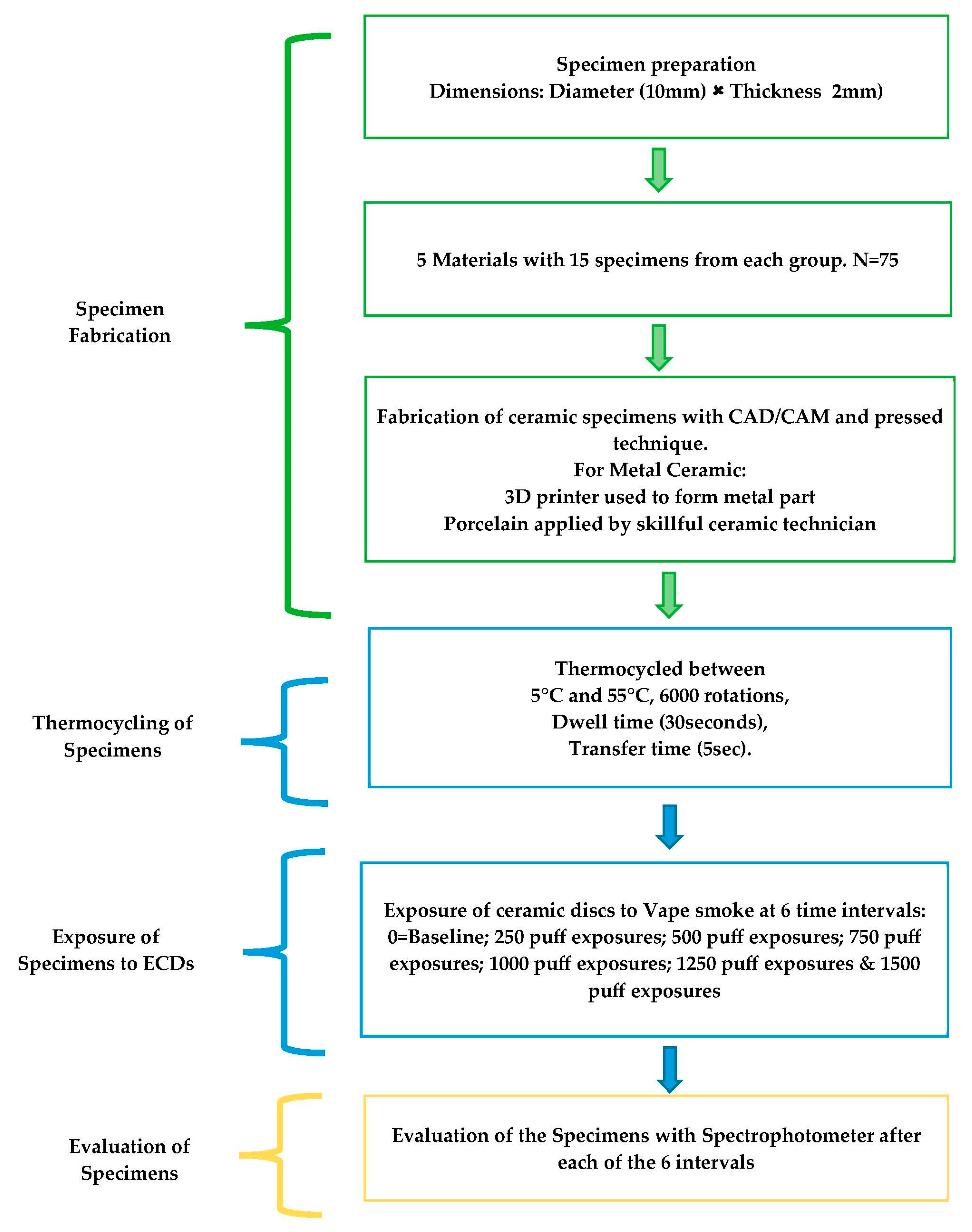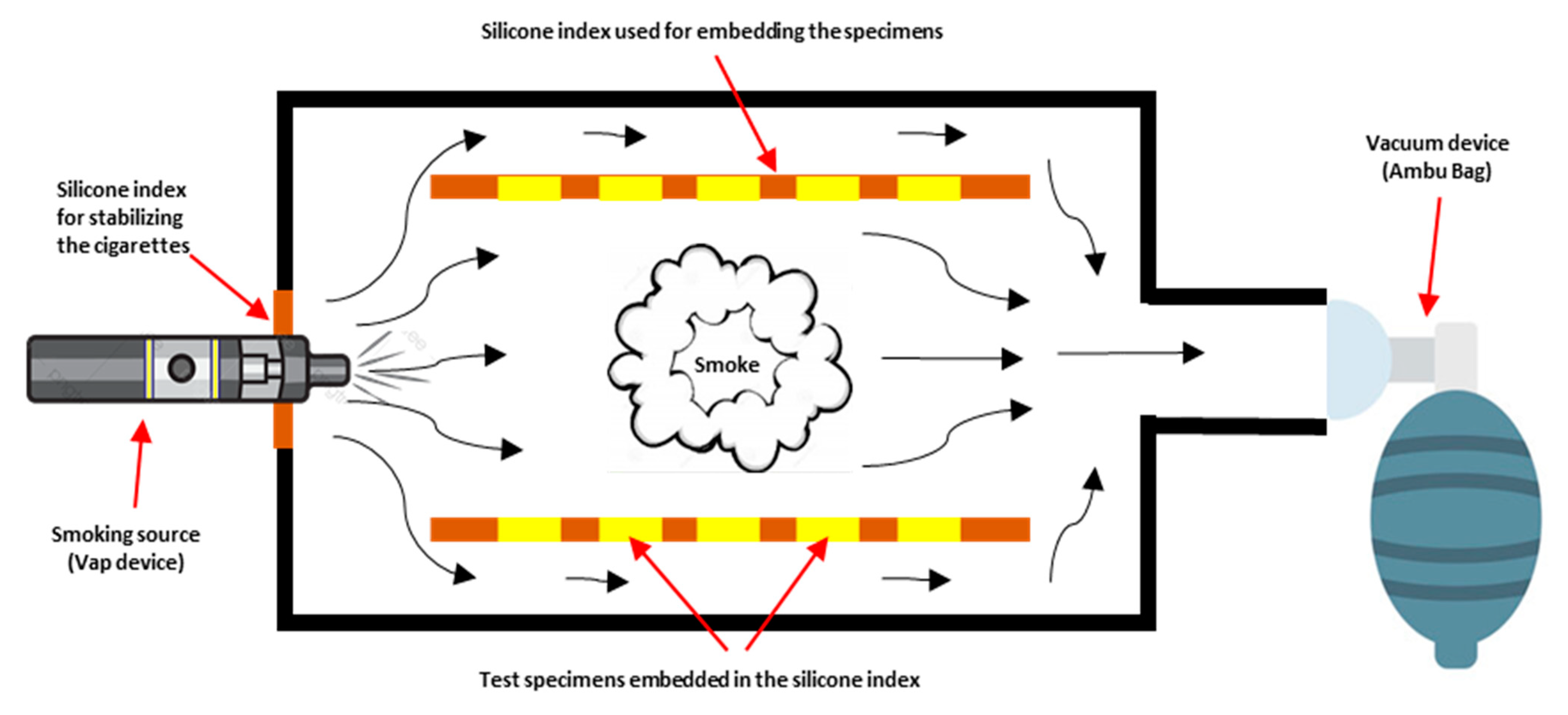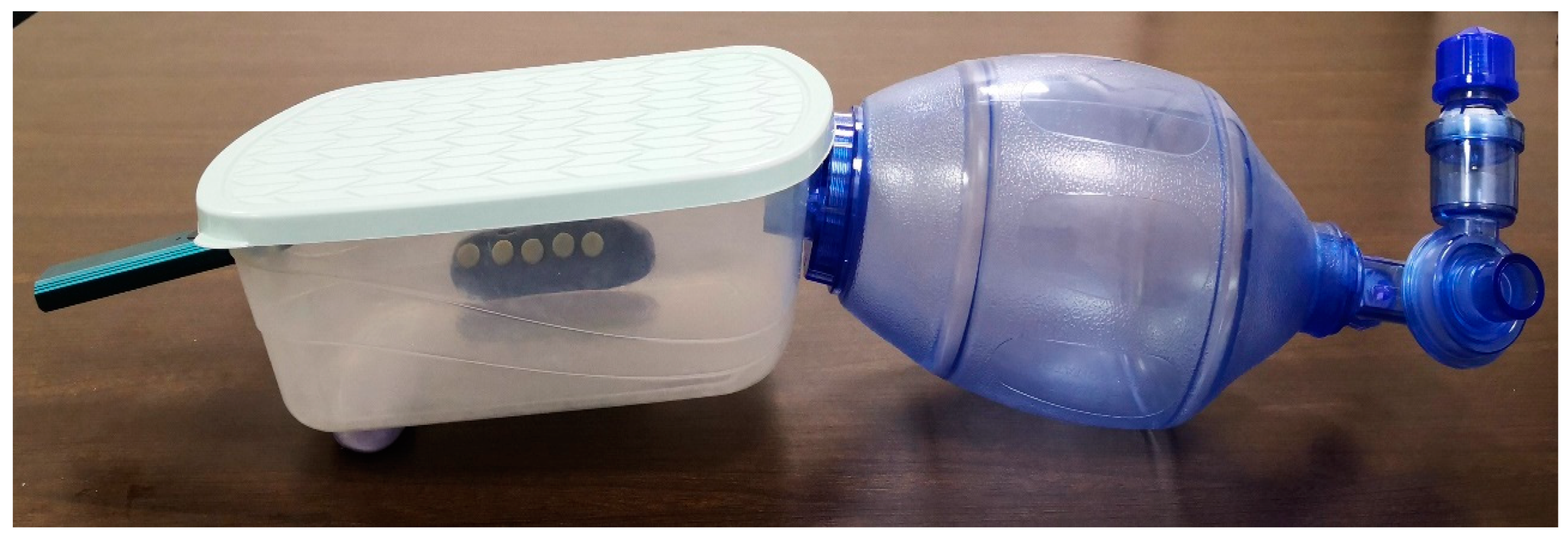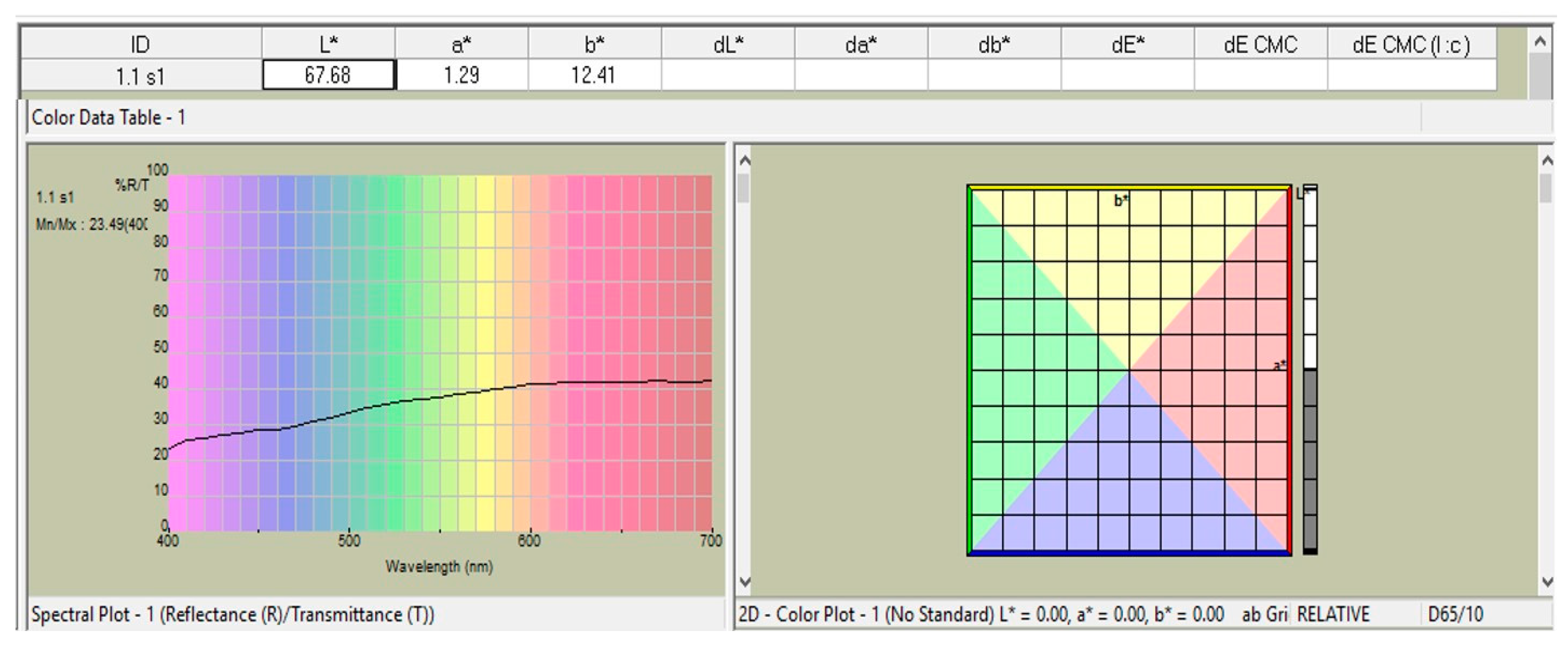Evaluation of the Effect of Electronic Cigarette Devices/Vape on the Color of Dental Ceramics: An In Vitro Investigation
Abstract
:1. Introduction
2. Materials and Methods
2.1. Selected Materials
2.2. Sample Size Calculation
2.3. Sample Fabrication
2.4. Thermocycling of Specimens
2.5. ECDs/Vape Puff Exposures
2.6. Spectrophotometric Analysis
2.7. Statistical Tests
3. Results
4. Discussion
5. Conclusions
Author Contributions
Funding
Institutional Review Board Statement
Informed Consent Statement
Data Availability Statement
Acknowledgments
Conflicts of Interest
References
- Blatz, M.B.; Chiche, G.; Bahat, O.; Roblee, R.; Coachman, C.; Heymann, H.O. Evolution of Aesthetic Dentistry. J. Dent. Res. 2019, 98, 1294–1304. [Google Scholar] [CrossRef] [PubMed]
- de Matos, J.D.M.; Lopes, G.R.S.; Queiroz, D.A.; Nakano, L.J.N.; Ribeiro, N.C.R.; Barbosa, A.B.; Anami, L.C.; Bottino, M.A. Dental Ceramics: Fabrication Methods and Aesthetic Characterization. Coatings 2022, 12, 1228. [Google Scholar] [CrossRef]
- Warreth, A.; Elkareimi, Y. All-ceramic restorations: A review of the literature. Saudi Dent. J. 2020, 32, 365–372. [Google Scholar] [CrossRef] [PubMed]
- Lamont, R.J.; Koo, H.; Hajishengallis, G. The oral microbiota: Dynamic communities and host interactions. Nat. Rev. Microbiol. 2018, 16, 745–759. [Google Scholar] [CrossRef]
- Alrabeah, G.; Shabib, S.; Almomen, R.; Alhedeithi, N.; Alotaibi, S.; Habib, S.R. Effect of Home Bleaching on the Optical Properties and Surface Roughness of Novel Aesthetic Dental Ceramics. Coatings 2023, 13, 330. [Google Scholar] [CrossRef]
- Tanthanuch, S.; Kukiattrakoon, B.; Thongsroi, T.; Saesaw, P.; Pongpaiboon, N.; Saewong, S. In vitro surface and color changes of tooth-colored restorative materials after sport and energy drink cyclic immersions. BMC Oral. Health 2022, 22, 578. [Google Scholar] [CrossRef] [PubMed]
- World Health Organisation. Tobacco: Key Facts. Available online: https://www.who.int/news-room/fact-sheets/detail/tobacco (accessed on 13 April 2023).
- Zhang, Y.; He, J.; He, B.; Huang, R.; Li, M. Effect of tobacco on periodontal disease and oral cancer. Tob. Induc. Dis. 2019, 17, 40. [Google Scholar] [CrossRef]
- Zanetti, F.; Zhao, X.; Pan, J.; Peitsch, M.C.; Hoeng, J.; Ren, Y. Effects of cigarette smoke and tobacco heating aerosol on color stability of dental enamel, dentin, and composite resin restorations. Quintessence Int. 2019, 50, 156–166. [Google Scholar]
- Dalrymple, A.; Badrock, T.C.; Terry, A.; Barber, M.; Hall, P.J.; Thorne, D.; Gaca, M.D.; Coburn, S.; Proctor, C. Assessment of enamel discoloration in vitro following exposure to cigarette smoke and emissions from novel vapor and tobacco heating products. Am. J. Dent. 2018, 31, 227–233. [Google Scholar]
- Karanjkar, R.R.; Preshaw, P.M.; Ellis, J.S.; Holliday, R. Effect of tobacco and nicotine in causing staining of dental hard tissues and dental materials: A systematic review and meta-analysis. Clin. Exper. Dent. Res. 2022, 9, 150–164. [Google Scholar] [CrossRef]
- Dalrymple, A.; Bean, E.J.; Badrock, T.C.; Weidman, R.A.; Thissen, J.; Coburn, S.; Murphy, J. Enamel staining with E-cigarettes, tobacco heating products and modern oral nicotine products compared with cigarettes and snus: An in vitro study. Am. J. Dent. 2021, 34, 3–9. [Google Scholar] [PubMed]
- Vohra, F.; Andejani, A.; Alamri, O.; Alshehri, A.; Al-Hamdan, R.S.; Almohareb, T.; Abduljabbar, T. Influence of electronic nicotine delivery systems (ENDS) in comparison to conventional cigarette on color stability of dental restorative materials. Pakistan J. Med. Sci. 2020, 36, 993–998. [Google Scholar] [CrossRef]
- Marques, P.; Piqueras, L.; Sanz, M.J. An updated overview of e-cigarette impact on human health. Respir. Res. 2021, 22, 151. [Google Scholar] [CrossRef]
- Vapex E-Cigarettes. Vapex E-Cigarette Freestarter Kit. Truth in Advertising. Available online: https://www.truthinadvertising.org/vapex-e-cigarette-freestarter-kit/ (accessed on 2 November 2020).
- Pintado-Palomino, K.; de Almeida, C.V.V.B.; Oliveira-Santos, C.; Pires-de-Souza, F.P.; Tirapelli, C. The effect of electronic cigarettes on dental enamel color. J. Esthet. Rest. Dent. 2019, 31, 160–165. [Google Scholar] [CrossRef] [PubMed]
- Alnasser, H.A.; Elhejazi, A.A.; Al-Abdulaziz, A.A.; Alajlan, S.S.; Habib, S.R. Effect of Conventional and Electronic Cigarettes Smoking on the Color Stability and Translucency of Tooth Colored Restorative Materials: An In Vitro Analysis. Coatings 2021, 11, 1568. [Google Scholar] [CrossRef]
- Habib, S.R.; Rashoud, A.S.; Safhi, T.A.; Almajed, A.H.; Alnafisah, H.A.; Bajunaid, S.O.; Alqahtani, A.S.; Alqahtani, M. Variations in the shades of contemporary dental ceramics: An In Vitro analysis. Crystals 2021, 11, 1288. [Google Scholar] [CrossRef]
- Paolone, G.; Pavan, F.; Guglielmi, P.C.; Scotti, N.; Cantatore, G.; Vichi, A. In vitro procedures for color stability evaluation of dental resin-based composites exposed to smoke: A scoping review. Dent. Mater. J. 2022, 41, 791–799. [Google Scholar] [CrossRef]
- Eaton, D.L.; Kwan, L.Y.; Stratton, K.; National Academies of Sciences, Engineering, and Medicine. E-cigarette devices, uses, and exposures. In Public Health Consequences of E-Cigarettes; National Academies Press: Washington, DC, USA, 2018. [Google Scholar]
- Ebersole, J.; Samburova, V.; Son, Y.; Cappelli, D.; Demopoulos, C.; Capurro, A.; Pinto, A.; Chrzan, B.; Kingsley, K.; Howard, K.; et al. Harmful chemicals emitted from electronic cigarettes and potential deleterious effects in the oral cavity. Tob. Induc. Dis. 2020, 18, 41. [Google Scholar] [CrossRef]
- Papaefstathiou, E.; Stylianou, M.; Agapiou, A. Main and side stream effects of electronic cigarettes. J. Environ. Manag. 2019, 238, 10–17. [Google Scholar] [CrossRef]
- Kyriakos, C.N.; Filippidis, F.T.; Hitchman, S.; Girvalaki, C.; Tzavara, C.; Demjén, T.; Fernandez, E.; Mons, U.; Trofor, A.; Tountas, Y.; et al. Characteristics and correlates of electronic cigarette product attributes and undesirable events during e-cigarette use in six countries of the EUREST-PLUS ITC Europe Surveys. Tob. Induc. Dis. 2018, 16, A1. [Google Scholar] [CrossRef]
- Smew, A.A.M.; Yildirim, G.; Guven, M.C. Effect of cigarette smoking on the color stability and surface roughness of two different denture base materials. Am. J. Dent. 2022, 35, 25–29. [Google Scholar] [PubMed]
- Haiduc, A.; Zanetti, F.; Zhao, X.; Schlage, W.K.; Scherer, M.; Pluym, N.; Schlenger, P.; Ivanov, N.V.; Majeed, S.; Hoeng, J.; et al. Analysis of chemical deposits on tooth enamel exposed to total particulate matter from cigarette smoke and tobacco heating system 2.2 aerosol by novel GC-MS deconvolution procedures. J. Chromatogr. B 2020, 1152, 122228. [Google Scholar] [CrossRef] [PubMed]
- Paolone, G.; Pavan, F.; Mandurino, M.; Baldani, S.; Guglielmi, P.C.; Scotti, N.; Cantatore, G.; Vichi, A. Color stability of resin-based composites exposed to smoke. A systematic review. J. Esthet. Restor. Dent. 2023, 35, 309–321. [Google Scholar] [CrossRef]
- Schelkopf, S.; Dini, C.; Beline, T.; Wee, A.G.; Barão, V.A.R.; Sukotjo, C.; Yuan, J.C.-C. The Effect of Smoking and Brushing on the Color Stability and Stainability of Different CAD/CAM Restorative Materials. Materials 2022, 15, 6901. [Google Scholar] [CrossRef]
- What is Delta E? And Why Is It Important for Color Accuracy? Available online: https://www.viewsonic.com/library/creative-work/what-is-delta-e-and-why-is-it-important-for-color-accuracy/ (accessed on 13 April 2023).
- Comba, A.; Paolone, G.; Baldi, A.; Vichi, A.; Goracci, C.; Bertozzi, G.; Scotti, N. Effects of substrate and cement shade on the translucency and color of cad/cam lithium- disilicate and zirconia ceramic materials. Polymers 2022, 14, 1778. [Google Scholar] [CrossRef] [PubMed]
- Ban, S. Classification and Properties of Dental Zirconia as Implant Fixtures and Superstructures. Materials 2021, 14, 4879. [Google Scholar] [CrossRef]
- Zhang, Y.; Lawn, B.R. Novel zirconia materials in dentistry. J. Dent. Res. 2018, 97, 140–147. [Google Scholar] [CrossRef]
- Ziyad, T.A.; Abu-Naba’a, L.A.; Almohammed, S.N. Optical properties of CAD-CAM monolithic systems compared: Three multi-layered zirconia and one lithium disilicate system. Heliyon 2021, 7, e08151. [Google Scholar] [CrossRef]
- Zhao, M.; Sun, Y.; Zhang, J.; Zhang, Y. Novel translucent and strong submicron alumina ceramics for dental restorations. J. Dent. Res. 2018, 97, 289–295. [Google Scholar] [CrossRef]
- Primack, B.A.; Shensa, A.; Sidani, J.E.; Hoffman, B.L.; Soneji, S.; Sargent, J.D.; Hoffman, R.M.; Fine, M.J. Initiation of Traditional Cigarette Smoking after Electronic Cigarette Use among Tobacco-Naïve US Young Adults. Am. J. Med. 2018, 131, 443–449. [Google Scholar] [CrossRef]
- Wagener, T.L.; Avery, J.A.; Leavens, E.L.S.; Simmons, W.K. Associated Changes in E-cigarette Puff Duration and Cigarettes Smoked per Day. Nicotine Tob. Res. 2021, 23, 760–764. [Google Scholar] [CrossRef] [PubMed]
- Unger, M.; Unger, D.W. E-cigarettes/electronic nicotine delivery systems: A word of caution on health and new product development. J. Thorac. Dis. 2018, 10 (Suppl. S22), S2588–S2592. [Google Scholar] [CrossRef] [PubMed]
- Ko, T.J.; Kim, S.A. Effect of Heating on Physicochemical Property of Aerosols during Vaping. Int. J. Environ. Res. Public Health 2022, 19, 1892. [Google Scholar] [CrossRef] [PubMed]
- Gómez-Polo, C.; Montero, J.; Gómez-Polo, M.; Martin Casado, A. Comparison of the CIELab and CIEDE 2000 Color Difference Formulas on Gingival Color Space. J. Prosthodont. 2020, 29, 401–408. [Google Scholar] [CrossRef]




| S. No. | Group | Material | Trade Name | Manufacturer | Lot Number |
|---|---|---|---|---|---|
| 1. | PEmax | Pressable ceramic | IPS e.max Press | Ivoclar Vivadent AG Schaan, Principality of Liechtenstein. | A1 = Y05769 B1 = Y44299; C1 = 605274 |
| 2. | LEmax | Pressable | IPS e.max Press | Ivoclar Vivadent AG Schaan, Principality of Liechtenstein. | A1 = Y05769 B1 = Y44299; C1 = 605274 |
| Ceramic layer | IPS InLine Dentin | Ivoclar Vivadent AG Schaan, Principality of Liechtenstein. | A1 = W39158; B1 = W40241; C1 = R71757 | ||
| 3. | LZr | Zirconia core | ZI, LT, Zolid * CAD/CAM material | Amann Girrbach, Koblach, Austria. | 1905001 |
| Layering ceramic | IPS Inline Dentin | Ivoclar Vivadent AG Schaan, Principality of Liechtenstein | A1 = W39158; B1 = W40241; C1 = R71757 | ||
| 4. | MZr | Zirconia block | Zolid gen-x * CAD/CAM material | Amann Girrbach, Koblach, Austria. | 1905001 |
| Frame shade | Dying liquid | 3M ESPE, MN 55144 USA | A1 = 68346 B1 = 68574 C1 = 68579 | ||
| 5. | PFM | Metal | Starbond easy powder 30 | Scheftner dental alloys, S&S Scheftner GmbH, Germany | 0223060919 |
| Ceramic | IPS InLine Dentin | Ivoclar Vivadent AG Schaan, Principality of Liechtenstein. | A1 = W39158; B1 = W40241; C1 = R71757 |
| Exposure Timing | PEmax | LEmax | LZr | MZr | PFM | |||||
|---|---|---|---|---|---|---|---|---|---|---|
| Mean | SD * | Mean | SD | Mean | SD | Mean | SD | Mean | SD | |
| 0 ** | 69.28 | 4.41 | 59.61 | 3.31 | 61.04 | 1.43 | 57.46 | 1.09 | 66.84 | 1.46 |
| 250 | 70.55 | 1.74 | 61.85 | 0.96 | 71.112 | 0.57 | 59.07 | 0.82 | 67.26 | 1.20 |
| 500 | 70.86 | 1.20 | 61.9 | 1.08 | 71.29 | 0.43 | 59.25 | 0.60 | 67.60 | 1.08 |
| 750 | 71.02 | 1.07 | 62.03 | 0.70 | 71.97 | 0.65 | 59.66 | 0.45 | 67.68 | 1.11 |
| 1000 | 71.11 | 0.87 | 62.85 | 0.57 | 72.34 | 0.37 | 60.33 | 0.47 | 68.12 | 1.58 |
| 1250 | 71.14 | 1.41 | 63.48 | 0.70 | 72.73 | 0.52 | 60.37 | 0.32 | 68.43 | 1.02 |
| 1500 | 71.39 | 1.11 | 64.53 | 2.24 | 72.95 | 0.82 | 61.01 | 0.47 | 68.61 | 1.38 |
| Exposure Timing | PEmax | LEmax | LZr | MZr | PFM | |||||
|---|---|---|---|---|---|---|---|---|---|---|
| Mean | SD * | Mean | SD | Mean | SD | Mean | SD | Mean | SD | |
| 0 ** | −1.00 | 0.13 | −2.01 | 0.14 | −0.54 | 0.09 | −2.28 | 0.26 | 1.12 | 0.23 |
| 250 | −1.02 | 0.11 | −2.04 | 0.09 | −0.54 | 0.21 | −2.39 | 0.26 | 1.17 | 0.21 |
| 500 | −1.04 | 0.08 | −2.21 | 0.04 | −0.67 | 0.22 | −2.49 | 0.27 | 1.16 | 0.23 |
| 750 | −1.11 | 0.07 | −2.20 | 0.03 | −0.62 | 0.22 | −2.59 | 0.28 | 1.12 | 0.22 |
| 1000 | −1.00 | 0.10 | −2.20 | 0.03 | −0.67 | 0.22 | −2.44 | 0.24 | 1.32 | 0.22 |
| 1250 | −1.06 | 0.07 | −2.11 | 0.04 | −0.64 | 0.21 | −2.41 | 0.24 | 1.17 | 0.23 |
| 1500 | −1.11 | 0.09 | −1.71 | 0.31 | −0.81 | 0.23 | −2.39 | 0.27 | 1.16 | 0.23 |
| Exposure Timing | PEmax | LEmax | LZr | MZr | PFM | |||||
|---|---|---|---|---|---|---|---|---|---|---|
| Mean | SD * | Mean | SD | Mean | SD | Mean | SD | Mean | SD | |
| 0 ** | 8.59 | 0.42 | 4.49 | 0.37 | 10.17 | 0.36 | −0.36 | 0.68 | 12.62 | 0.42 |
| 250 | 8.63 | 0.58 | 4.19 | 0.36 | 9.80 | 0.45 | −0.52 | 0.71 | 12.76 | 0.45 |
| 500 | 8.77 | 0.41 | 4.09 | 0.36 | 9.99 | 0.28 | −0.49 | 0.80 | 12.74 | 0.44 |
| 750 | 8.62 | 0.35 | 4.05 | 0.40 | 10.08 | 0.28 | −0.80 | 0.80 | 12.71 | 0.36 |
| 1000 | 8.92 | 0.30 | 4.28 | 0.32 | 10.13 | 0.30 | −0.25 | 0.64 | 13.33 | 0.59 |
| 1250 | 8.74 | 0.35 | 4.82 | 0.35 | 10.30 | 0.26 | −0.29 | 0.65 | 13.11 | 0.39 |
| 1500 | 8.71 | 0.44 | 5.89 | 0.251 | 10.72 | 0.30 | 0.18 | 0.70 | 13.04 | 0.43 |
| Exposure Timing | ΔE | |||||
|---|---|---|---|---|---|---|
| PEmax | LEmax | LZr | MZr | PFM | Anova p Value * | |
| 250 | 2.65 | 2.61 | 11.81 | 1.70 | 0.85 | 0.00 |
| 500 | 2.70 | 2.59 | 11.86 | 1.92 | 0.97 | 0.00 |
| 750 | 2.82 | 2.89 | 12.50 | 2.31 | 1.19 | 0.00 |
| 1000 | 2.83 | 3.41 | 12.83 | 2.89 | 1.75 | 0.00 |
| 1250 | 3.05 | 3.92 | 13.26 | 2.93 | 1.72 | 0.00 |
| 1500 | 3.09 | 4.69 | 13.67 | 3.64 | 1.92 | 0.00 |
| Anova p value ** | 0.999 | 0.000 | 0.002 | 0.001 | 0.001 | |
Disclaimer/Publisher’s Note: The statements, opinions and data contained in all publications are solely those of the individual author(s) and contributor(s) and not of MDPI and/or the editor(s). MDPI and/or the editor(s) disclaim responsibility for any injury to people or property resulting from any ideas, methods, instructions or products referred to in the content. |
© 2023 by the authors. Licensee MDPI, Basel, Switzerland. This article is an open access article distributed under the terms and conditions of the Creative Commons Attribution (CC BY) license (https://creativecommons.org/licenses/by/4.0/).
Share and Cite
Alrabeah, G.; Habib, S.R.; Alamro, N.M.; Alzaaqi, M.A. Evaluation of the Effect of Electronic Cigarette Devices/Vape on the Color of Dental Ceramics: An In Vitro Investigation. Materials 2023, 16, 3977. https://doi.org/10.3390/ma16113977
Alrabeah G, Habib SR, Alamro NM, Alzaaqi MA. Evaluation of the Effect of Electronic Cigarette Devices/Vape on the Color of Dental Ceramics: An In Vitro Investigation. Materials. 2023; 16(11):3977. https://doi.org/10.3390/ma16113977
Chicago/Turabian StyleAlrabeah, Ghada, Syed Rashid Habib, Nawaf M. Alamro, and Meshari A. Alzaaqi. 2023. "Evaluation of the Effect of Electronic Cigarette Devices/Vape on the Color of Dental Ceramics: An In Vitro Investigation" Materials 16, no. 11: 3977. https://doi.org/10.3390/ma16113977
APA StyleAlrabeah, G., Habib, S. R., Alamro, N. M., & Alzaaqi, M. A. (2023). Evaluation of the Effect of Electronic Cigarette Devices/Vape on the Color of Dental Ceramics: An In Vitro Investigation. Materials, 16(11), 3977. https://doi.org/10.3390/ma16113977








